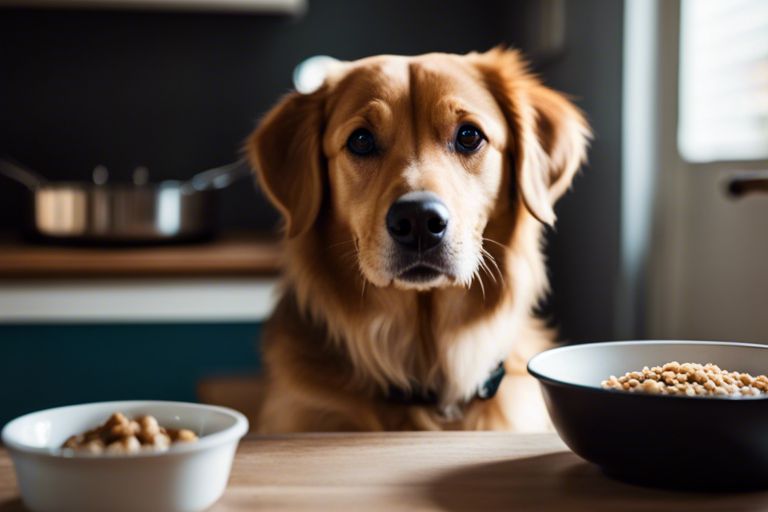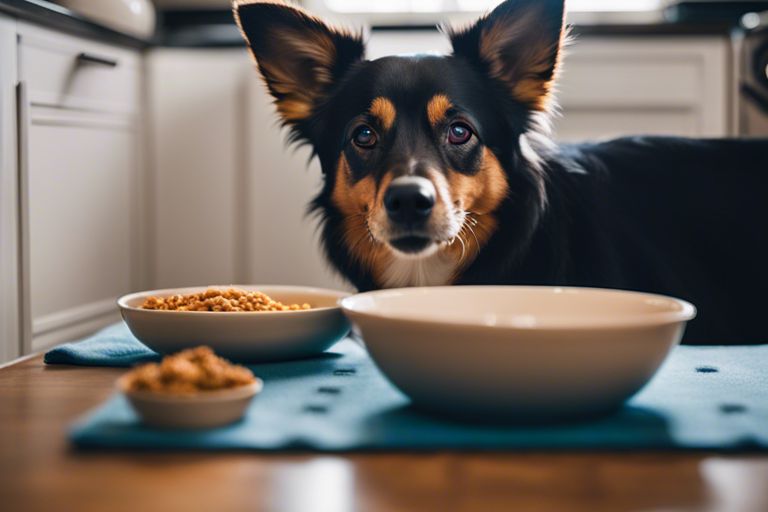Dogs, the beloved companions of many, have specific dietary needs that should be carefully considered. The age-old question of whether they should consume their meals once or twice a day has puzzled pet owners for years. In this informative blog post, we explore into the pros and cons of each feeding schedule to help you make the best decision for your furry friend’s health and happiness. Let’s explore the optimal feeding routine for our canine companions.
Key Takeaways:
- Dog’s Feeding Schedule: The debate between feeding dogs once or twice a day is largely dependent on the dog’s age, activity level, and health condition.
- Once-a-Day Feeding: For some adult dogs, feeding them once a day can be beneficial in controlling weight and preventing certain health issues like bloat.
- Twice-a-Day Feeding: Puppies, senior dogs, and dogs with certain health conditions may benefit from being fed twice a day to maintain energy levels and support proper digestion.
- Consulting a Veterinarian: It is important to consult with a veterinarian to determine the most suitable feeding schedule for your individual dog based on their specific needs.
- Consistency and Balance: Regardless of whether your dog is fed once or twice a day, ensuring a consistent schedule and providing a balanced diet is crucial for their overall health and well-being.
The Importance of Nutrition for Dogs
A healthy diet is vital for the well-being of our canine companions. Just like humans, dogs require a balanced diet to thrive. According to Southern Living, understanding what and when to feed your dog can have a significant impact on their health and longevity.
Nutrient Requirements for Optimal Health
On a daily basis, dogs need a variety of nutrients to support their overall health. Proteins, fats, carbohydrates, vitamins, and minerals are vital for their growth, energy levels, and immune function. It is crucial to provide a well-balanced diet that meets all these nutritional requirements to ensure your dog’s optimal health and development.
How Meal Frequency Affects Digestion
Health experts suggest that how often you feed your dog can also impact their digestion and well-being. While some dog owners prefer feeding their pets once a day, others opt for two smaller meals. Each approach has its benefits, and the decision should be based on your dog’s individual needs and preferences.
With that said, splitting your dog’s daily food intake into multiple meals can help regulate their digestion and prevent issues like bloating. It can also provide a more consistent energy level throughout the day, especially for highly active dogs.
The Pros of Feeding Dogs Once a Day
Some pet owners may wonder about the benefits of feeding their dogs once a day versus twice a day. If you’re curious about this topic, you can explore more information on What are the benefits of feeding your dog once a day vs. twice a day.
Simplified Feeding Schedule
Once a day feeding can simplify your daily routine as a pet owner. You only have to worry about one feeding time, making it easier to manage and plan your day around your dog’s mealtime.
Reduced Risk of Overfeeding
Once a day feeding can help reduce the risk of overfeeding your dog. With one meal a day, you have better control over portion sizes and can monitor your dog’s food intake more effectively.
It is vital to pay attention to your dog’s weight and body condition to ensure they are receiving the appropriate amount of food for their size and activity level.
Improved Digestion and Absorption
Risking potential digestive issues, feeding your dog once a day can help improve their digestion and nutrient absorption. A longer fasting period between meals allows for a more complete digestion process and better absorption of vital nutrients from their food.
Feeding your dog once a day may also help regulate their bowel movements and contribute to overall digestive health.
The Cons of Feeding Dogs Once a Day
Once again, the debate on whether dogs should be fed once or twice a day continues to be a topic of discussion among pet owners. While some may argue that feeding dogs once a day fits their schedule better, there are several downsides to consider.
Potential for Hunger and Discomfort
Once dogs get accustomed to a feeding schedule, eating only once a day may leave them feeling hungry and uncomfortable for long periods. This can lead to behavioral issues, such as begging for food or scavenging for scraps, which can be frustrating for both the pet and the owner.
Increased Risk of Gastric Dilatation-Volvulus (GDV)
One potential risk of feeding dogs once a day is the increased likelihood of developing Gastric Dilatation-Volvulus (GDV), a serious condition where the stomach fills with gas and twists on itself. This can be a life-threatening emergency that requires immediate veterinary attention to correct.
Discomfort such as bloating, abdominal pain, and difficulty breathing are common symptoms of GDV. Larger, deep-chested breeds are particularly prone to this condition, making it crucial to consider their feeding schedule to minimize the risk.
Negative Impact on Blood Sugar Levels
Blood sugar levels in dogs can be influenced by their feeding schedule. Feeding dogs once a day can lead to fluctuations in blood sugar levels, which may result in episodes of weakness, lethargy, or possibly even more severe conditions like hypoglycemia.
Gastric dilatation, combined with low blood sugar levels, can further exacerbate the risk of health complications in dogs. It is imperative to provide a balanced feeding schedule to maintain stable blood sugar levels and overall well-being.
The Benefits of Feeding Dogs Twice a Day
Maintaining Stable Energy Levels
An crucial benefit of feeding dogs twice a day is that it helps in maintaining stable energy levels throughout the day. By dividing their daily food intake into two meals, you can ensure that your furry friend has a sustained source of energy to keep them active and happy.
Reduced Hunger and Increased Satisfaction
With twice-daily feedings, your dog is less likely to experience prolonged periods of hunger between meals. This can help reduce begging behavior and prevent them from scavenging for food elsewhere. Additionally, having two meals a day may increase your dog’s overall satisfaction, as they can look forward to regular feeding times.
With a structured feeding schedule, your dog will learn when to expect their meals, creating a sense of routine and predictability in their day. This can contribute to their overall well-being and mental health.
Improved Blood Sugar Regulation
Levels
Feeding your dog twice a day can also aid in improved blood sugar regulation. By spacing out their meals, you can prevent spikes and drops in their blood sugar levels, reducing the risk of hypoglycemia and helping them maintain a steady glucose level throughout the day.
Plus
Further, feeding your dog smaller, more frequent meals can be beneficial for breeds prone to hypoglycemia or diabetes. This feeding schedule can help manage their conditions and ensure they have a consistent source of energy without overloading their system at once.
The Drawbacks of Feeding Dogs Twice a Day
For How many times a day should I feed my dog? , feeding dogs twice a day may come with some drawbacks that pet owners should consider.
Increased Risk of Overfeeding and Obesity
Obesity is a significant concern for dogs fed twice a day. With two meals, there is a higher likelihood of overfeeding if portion sizes are not carefully monitored. This excess caloric intake can lead to weight gain and obesity, which can have negative implications for a dog’s overall health and quality of life.
Higher Cost and Resource Demands
Dogs fed twice a day may incur higher costs for pet owners. From purchasing extra food to potentially requiring additional treats for training or snacks between meals, the expenses can add up. Moreover, the time and resources needed to prepare and serve two meals a day may not be feasible for all pet owners, especially those with busy schedules.
Resource
It’s important to consider the financial and time commitments of feeding dogs twice a day, as it may not be practical for every pet owner.
Potential Disruption to Digestive Rhythm
Feeding dogs twice a day can disrupt their natural digestive rhythm. Dogs are accustomed to eating one larger meal in a day, which aligns with their ancestral feeding patterns. Splitting their food into two portions may lead to irregular bowel movements or digestive issues as their bodies try to adjust to this new schedule.
It’s crucial to observe any changes in your dog’s digestion and behavior when transitioning to feeding them twice a day to ensure they are comfortable and healthy.
Factors to Consider When Deciding on Meal Frequency
Many factors come into play when deciding whether your dog should eat once or twice a day. Here are some key considerations:
Age, Breed, and Size of the Dog
- One of the most important factors to consider is the age, breed, and size of your dog. Puppies, for example, may need to eat more frequently than adult dogs due to their higher energy levels and growth requirements.
- Small breeds may also benefit from more frequent meals to prevent hypoglycemia, while large breeds may do well with one or two larger meals to prevent bloat.
After taking into account these factors, you can determine the best meal frequency for your dog’s specific needs.
Activity Level and Lifestyle
Deciding how often to feed your dog also depends on their activity level and lifestyle. Dogs who are highly active or working dogs may require more frequent meals to sustain their energy levels throughout the day. On the other hand, sedentary dogs or those with a more relaxed lifestyle may do just fine with one or two meals a day.
Frequency should be adjusted based on your dog’s individual needs and habits. It is crucial to observe your dog’s behavior and appetite to determine the most suitable meal frequency.
Health Status and Medical Conditions
When considering your dog’s meal frequency, it is crucial to take into account their health status and any underlying medical conditions they may have. Dogs with certain health issues, such as diabetes or gastrointestinal problems, may require a specific feeding schedule to manage their condition effectively.
It is important to consult with your veterinarian to determine the best meal frequency for a dog with special health considerations. They can provide valuable guidance tailored to your dog’s specific needs.
To wrap up
Upon reflecting on the information provided, it is clear that the debate over whether dogs should eat once or twice a day ultimately comes down to the individual needs of the dog. Factors such as age, activity level, and overall health should be taken into consideration when determining the best feeding schedule. While some dogs may do well with one large meal a day, others may benefit from smaller, more frequent meals. It is important for pet owners to consult with their veterinarian to determine the best feeding routine for their furry companion.
In the end, the most important thing is to ensure that your dog is receiving a balanced diet that meets their nutritional needs. By paying attention to your dog’s individual needs and consulting with a professional, you can ensure that your beloved pet is happy, healthy, and well-fed.
FAQ
Q: How often should dogs eat in a day?
A: Dogs should ideally eat twice a day to maintain a healthy and balanced diet.
Q: Is it okay to feed my dog only once a day?
A: While some dogs can do fine with one meal a day, it is generally recommended to feed them twice a day to prevent overeating and maintain energy levels.
Q: What are the benefits of feeding my dog twice a day?
A: Feeding your dog twice a day can help regulate their metabolism, prevent hunger pangs, and reduce the risk of gastric torsion (bloat).
Q: How should I divide my dog’s meals if feeding twice a day?
A: It is recommended to split your dog’s daily food portion into two equal meals, one in the morning and one in the evening, to provide consistent energy throughout the day.
Q: Can I adjust my dog’s feeding schedule based on their activity level?
A: Yes, you can adjust the timing and portion sizes of your dog’s meals based on their age, size, activity level, and overall health. Consulting with a veterinarian can help determine the best feeding schedule for your furry friend.
Are strawberries toxic for dogs
Demystifying Anal Gland Issues in Dogs: Your Comprehensive Guide from the American Kennel Club




